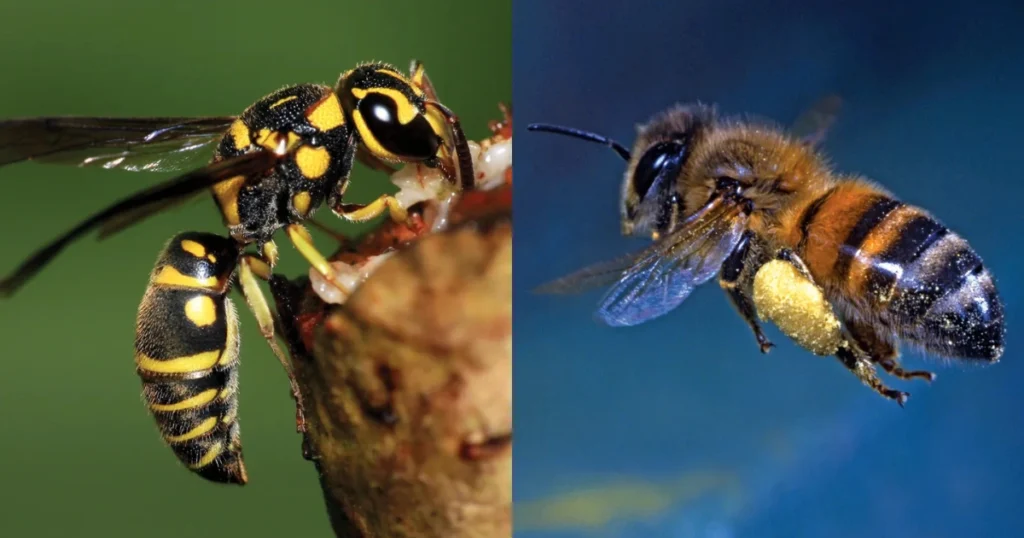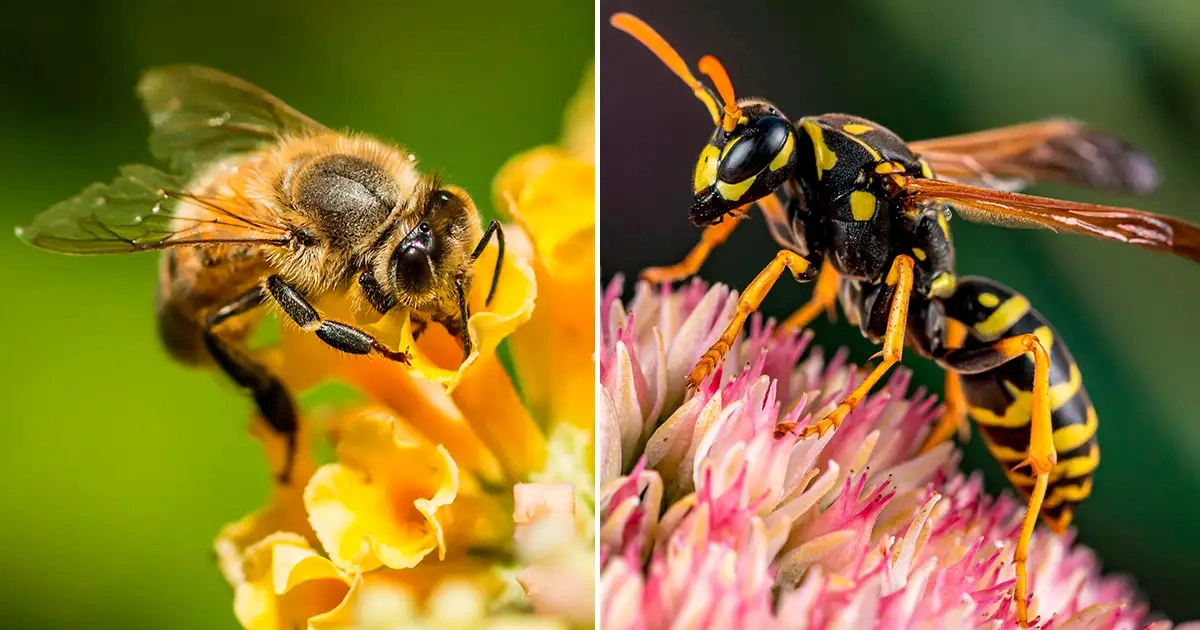It happens every summer—you’re enjoying a picnic or tending to your garden when suddenly a buzzing insect flies past your face. Panic sets in. But before you swat or run, stop and take a closer look. Not every buzzing insect is out to sting you. In fact, many of them are hardworking heroes of nature.
Knowing the difference between honeybees, bumblebees, and wasps can help you protect the good guys and avoid trouble with the not-so-friendly ones. Here’s how to tell who’s who—and why it matters.

🐝 Honeybee: The Sweet & Gentle Hero
Honeybees are the iconic pollinators that play a critical role in agriculture and wild ecosystems. You’ve probably seen them hovering near flowers or flying in and out of wooden hives.
They are golden-yellow with black stripes, relatively small, and often fuzzy.
Honeybees live in large, social colonies with a queen, thousands of workers, and a few drones. They build wax hives and produce honey from nectar.
They are incredibly efficient pollinators, helping fertilize crops like apples, almonds, melons, and blueberries.
Honeybees are typically calm and will only sting if provoked or defending their hive. Once they sting, they die—so they don’t do it lightly.
You’ll usually find them in gardens, near blooming plants, or around managed hives. They’re focused on flowers, not food or humans.
Let them do their job and they’ll leave you alone. Their presence is a sign of a healthy environment.
🐝 Bumblebee: The Fluffy Giant
Bumblebees are the teddy bears of the bee world—larger, rounder, and furrier than honeybees. They have a deep buzz and often seem clumsy in flight.
They are black with broad yellow or orange bands and are covered in soft fuzz.
Bumblebees live in small colonies, often underground or in hidden spaces like compost heaps. They’re not aggressive and rarely sting unless grabbed or cornered.
They are fantastic pollinators, especially for crops that require “buzz pollination,” like tomatoes and peppers. Their ability to vibrate flowers helps release pollen more efficiently.
You’ll spot bumblebees hovering low among flowers in gardens, meadows, or hedgerows. Their slow flight and heavy buzz make them easy to identify.
If you see one, enjoy the sight—bumblebees are gentle and vital for your garden.
😈 Wasp or Yellowjacket: The Striped Menace
Wasps often look similar to bees at first glance, but they behave very differently. They are sleeker, shinier, and far more aggressive.
They have thin waists, smooth bodies, and bold yellow and black coloring.
Unlike bees, wasps don’t produce honey and have little interest in flowers. Instead, they’re drawn to meat, sugary drinks, and human food.
They can sting multiple times without dying and are much more likely to attack unprovoked—especially in late summer when food becomes scarce.
Wasps don’t contribute significantly to pollination. Their main ecological role is pest control—they hunt other insects to feed their young.
They often build paper-like nests in eaves, attics, bushes, or underground burrows. If disturbed, they defend these nests aggressively.
They’re notorious for crashing picnics, buzzing soda cans, and stinging barefoot children in the yard.
While they serve a purpose in nature, they’re not guests you want hanging around your lunch.
🧠 Quick Identification Tips
If you’re unsure whether you’re dealing with a bee or a wasp, check these clues:
Bees are rounder, fuzzier, and often found on flowers.
Wasps are sleeker, shinier, and often hover near food or trash.
Bees rarely bother people and avoid conflict.
Wasps are territorial and will defend their space without hesitation.
If it’s fat, fuzzy, and chill—it’s probably a bee.
If it’s slim, shiny, and aggressive—it’s probably a wasp.
🏡 Why This Matters
Understanding the differences between bees and wasps isn’t just trivia—it can help you:
Protect essential pollinators in your garden
Avoid unnecessary fear or panic when you see a bee
Take smart steps to discourage wasps from nesting nearby
Teach children how to interact with insects calmly and safely
Bees are in decline worldwide due to habitat loss, pesticides, and climate change. By learning to recognize and respect them, you’re helping support biodiversity and food security.
Meanwhile, knowing how to identify and deal with wasps can keep your outdoor activities safer and less stressful.
🌼 Final Thoughts
Not all buzzers are villains. While wasps can be a nuisance, bees are peaceful and essential members of our ecosystem. They pollinate the plants that feed us, beautify our environment, and keep nature in balance.
So next time something buzzes by, take a breath and observe. Is it a fluffy bumblebee looking for flowers? A honeybee heading home with nectar? Or a wasp eyeing your sandwich?
Knowing the difference can turn fear into curiosity—and help you protect the good guys while staying safe from the troublemakers.


556171 938804Completely composed content material , thankyou for details . 319937
https://t.me/s/iGaming_live/4864
برای دوستانی که به دنبال یک راهکار مطمئن برای وریفای حساب در بروکرهای فارکس هستند، پیشنهاد میکنم خدمات شوپی را بررسی کنند. این مجموعه به صورت تخصصی، وریفای قانونی حساب های فارکس را با مدارکی ارائه میدهد که کاملاً معتبر بوده و به نام خودتان صادر میشود. این روش دائمی است و ریسک بلاک شدن حساب شما را به صفر میرساند. کیفیت و پشتیبانیشان واقعاً عالی است.
We appreciate your patience and understanding.Habe nun auf diese Antwort ein privates
Email an Verdecasino mit meiner Player ID geschickt und wieder keine Antwort.
As a licensed casino, we take all withdrawal requests seriously and aim to process them in compliance with our protocols.
Hatte hier eine Antwort von Verdecasino bekommen.
Der beschert einerseits Cashback Bonus und andererseits einen wöchentlichen Einzahlungsbonus.
Wer länger bei Verde Casino mit dabei ist, profitiert
vom Treuebonus. Als nächstes Goodie winkt der Willkommensbonus.
Ihr Punktestand bestimmt Ihre Position in der Rangliste, und nach Turnierende erhalten Sie einen Preis
aus dem Preispool. Wer die Kunst des Pokerspiels beherrscht,
hat die Chance, mit seinen Gewinnen seinen Lebensunterhalt zu bestreiten. Sie dauern nur wenige Sekunden und bieten Ihnen die Möglichkeit,
Ihr Spielbudget schnell zu erhöhen.
References:
https://online-spielhallen.de/princess-casino-online-slots-ubersicht-erfahrung/
https://t.me/s/BeEFcasInO_OffICiAlS